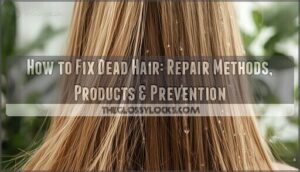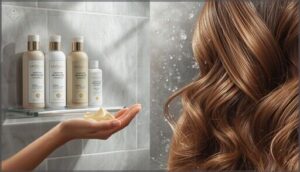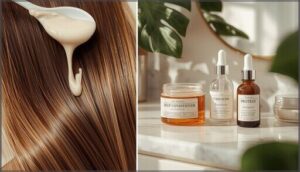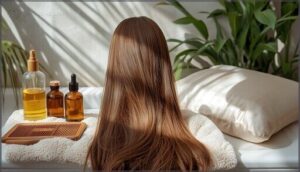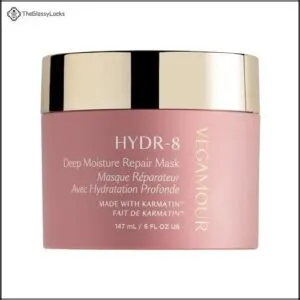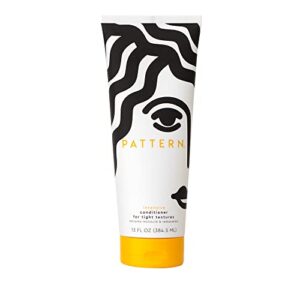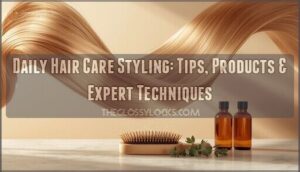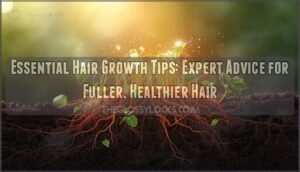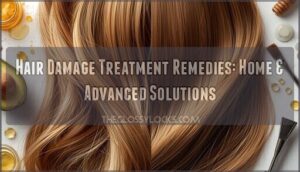This site is supported by our readers. We may earn a commission, at no cost to you, if you purchase through links.
When you run your fingers through your hair and feel straw instead of silk, you’re not imagining it—your hair has likely lost much of its structural integrity. The protein bonds that once held each strand together have broken down from heat, chemicals, or environmental stress, leaving behind a brittle shell of what healthy hair should be.
Dead hair doesn’t repair itself the way skin does, which is why strands snap off on your brush and split ends climb higher no matter how much conditioner you use.
The good news is that while you can’t resurrect truly dead ends, you can stop the damage from spreading and restore softness and strength to the rest of your hair through targeted repair methods and smarter daily habits.
Table Of Contents
Key Takeaways
- Truly dead hair can’t be repaired, but you can prevent more damage and restore softness and strength to the healthy parts through targeted routines.
- Switching to sulfate-free shampoo, using deep conditioners and protein treatments, and being gentle with brushing and drying make the biggest difference for damaged hair.
- Limiting heat styling, protecting your hair from sun and pollution, and getting regular trims are crucial for both recovery and prevention.
- Professional treatments like bond builders or seeking a specialist are best if home care and product changes aren’t improving your hair’s condition.
Signs and Causes of Dead Hair
Recognizing dead hair isn’t always obvious at first glance, but your strands will tell you when something’s wrong.
The damage you see on the surface often points back to specific causes, from the tools you use to the products you apply.
Understanding what’s happening and why can help you figure out where to start with repairs.
Common Signs of Severely Damaged Hair
When your hair feels more like straw than silk, your strands are telling you something important. Recognizing these warning signs early helps you take action before the damage becomes irreversible:
- Extreme Breakage and Split Ends – Your hair snaps when brushing, leaving visible fragments on your pillow and comb, with frayed tips indicating weakened protein bonds.
- Persistent Dryness and Tangled Texture – Strands resist moisture, forming stubborn knots that make detangling a painful, time-consuming task.
- Dull Appearance and Scalp Sensitivity – Hair loses its natural shine while your scalp feels tender or irritated, signaling compromised hair health from follicle to tip. Addressing these issues early can prevent further hair breakage.
Chemical, Heat, and Environmental Damage
Beyond the visible signs lies a more sobering truth: the forces destroying your hair often come from sources you use daily. Chemical treatments like relaxers and bleach break protein bonds deep within each strand, while thermal styling tools reaching over 200°C cause irreversible damage. UV radiation strips away keratin after just 30 hours of sun exposure, and urban pollution creates deep fissures in your hair’s protective outer layer. As heat styling tools become more common, the hair heat protectants market continues to grow.
| Damage Source | Primary Effect | Long-Term Consequence |
|---|---|---|
| Chemical Exposure | Broken protein bonds | Structural weakness, brittleness |
| Thermal Styling | Protein denaturation above 200°C | Permanent shaft damage |
| UV Radiation & Pollution | Keratin degradation, cuticle erosion | Color loss, split ends, dullness |
Modern heat protectants can reduce cuticle damage by up to 58%, but prevention beats correction every time. Regulatory bans on formaldehyde in Maryland and California reflect growing awareness that many styling products contain ingredients actively harming your hair. Understanding these threats allows you to make smarter choices for effective hair damage repair.
Daily Habits That Worsen Hair Health
Sometimes the real culprit isn’t what you’re using—it’s how you’re using it. Simple mistakes compound into serious hair damage over time:
- Excessive Brushing beyond once daily increases hair breakage and shedding, especially the outdated 100-strokes myth
- Rough Towel-Drying lifts cuticles and creates friction that leads to frizz and long-term damage
- Improper Shampooing by scrubbing the length instead of focusing on your scalp strips away protective oils
- Tight Hairstyles like ponytails restrict blood flow and cause traction alopecia from chronic tension
- Product Overuse clogs follicles and triggers scalp inflammation, reducing your hair’s growth potential
Your daily hair care routine matters more than you think. Wet hair is 30% more vulnerable to breakage, making those post-shower habits particularly critical. Hair styling tools and accessories you trust—rubber bands, metal clips—can snap weakened strands at contact points.
Step-by-Step Methods to Repair Dead Hair
Repairing dead hair takes a complete reset of your daily routine, from the products you use to how you handle your strands. The good news is that with the right approach, you can start seeing improvements in texture, strength, and overall health within a few weeks.
Here are five essential methods that address the root causes of damage and help restore your hair from the inside out.
Switching to Sulfate-Free, Moisturizing Shampoo
One of the simplest fixes starts in your shower. Switching to sulfate-free shampoo helps retain natural oils your hair desperately needs. Studies show sulfate-free formulas boost hair moisture by 22% and reduce breakage by nearly half. They also protect color treatments and soothe your scalp.
With market trends reflecting growing demand, these moisturizing shampoos offer proven hair repair benefits worth trying.
Using Deep Conditioning and Protein Treatments
After switching shampoos, you’ll want to layer in deep conditioning and protein treatments for real hair repair. Apply a deep conditioner from mid-shaft to ends once or twice weekly, leaving it on for 20–30 minutes to rebuild strength. Studies show these treatments reduce breakage by up to 50%.
Watch for protein overload—balance moisture with protein to avoid stiffness and maintain flexibility in your reviving damaged hair routine.
Gentle Brushing and Detangling Techniques
Brushing frequency matters more than you’d think—limiting it to once or twice daily keeps hair breakage in check, especially when you’re dealing with tangles. Start from the tips and work upward, sectioning hair to reduce knot incidence by about 35%. Tool selection is key for scalp health and preventing damage:
- Use a widetooth comb on wet hair to minimize stress
- Choose boar bristle brushes for fine strands
- Apply conditioner before detangling to lower friction
Gentle hair brushing techniques protect fragile fibers.
Washing Hair Less Frequently and With Lukewarm Water
While daily washing might feel invigorating, adjusting your hair washing frequency to 2–3 times per week with lukewarm water preserves natural oils and reduces scalp health issues. Hot water disrupts moisture retention, while lukewarm water maintains shampoo efficacy without stripping your scalp’s protective barrier.
Excessive washing removes sebum buildup but also strips essential oils, while infrequent cleansing clogs follicles and slows growth. Finding your balance is key for your hair care routine—lukewarm water cleanses effectively while preventing hair dryness and supporting long-term hair care tips for moisture retention.
| Hair Type | Ideal Frequency | Water Temperature |
|---|---|---|
| Fine/Thin | Every 1–2 days | Lukewarm |
| Medium/Thick | Every 2–4 days | Lukewarm |
| Curly/Coily | Every 1–2 weeks | Lukewarm |
Drying Hair Safely (T-Shirts, Microfiber Towels)
Traditional towels can increase friction by up to 40%, roughening your hair’s cuticle and triggering frizz. Switching to microfiber towels or cotton T-shirts transforms your hair damage prevention strategy by reducing mechanical stress and preserving moisture retention.
- Friction reduction: Microfiber generates 30–50% less friction, protecting cuticle integrity
- Moisture retention: Retain up to 15% more natural oils versus standard towels
- Frizz reduction: Cut frizz incidence by 38% with gentler drying methods
- Breakage prevention: Lower breakage rates by 21% through proper hair styling techniques
Preventing Further Hair Damage
Once you’ve started repairing your damaged hair, the next step is making sure you don’t end up back where you started. Prevention is honestly easier than repair, and a few simple changes to your routine can protect the progress you’ve made.
Here’s how to shield your hair from the most common culprits that cause damage in the first place.
Limiting Heat Styling and Using Heat Protectants
Think of heat styling like exposing your hair to a daily blast furnace—temperatures above 95°C crack the cuticle and weaken protein bonds. You can reduce split ends by over 30% when you limit heat tools to once weekly or less.
Heat styling above 95°C cracks your cuticle like a blast furnace—limit tools to weekly use and cut split ends by 30%
Always apply a heat protectant before styling; these products cut moisture loss by up to 50% and preserve cuticle integrity, keeping your hair smoother and stronger.
Protecting Hair From Sun and Environmental Stress
UV rays and pollution don’t just fade color—they strip away protein and moisture, leaving hair brittle. UVB protection through topical barriers like leave-in sprays shields your strands, while hats block direct sun exposure during peak hours. Darker hair’s melanin benefits offer natural defense, but everyone needs added protection.
Rinse after outdoor time to remove pollutants, and use antioxidant treatments weekly to counter environmental stress and preserve hair moisture and protection.
Regular Trims to Minimize Split Ends
Sun protection helps, but split ends still form over time—that’s where regular trims come in. Most stylists recommend trimming every 6 to 8 weeks to minimize split ends and maintain length. Early removal prevents splits from traveling upward, reducing breakage by up to 80%.
Consistent haircuts preserve strength, improve manageability, and keep your hair looking healthier while repairing damaged hair from the inside out.
Top 3 Products for Reviving Dead Hair
Once you’ve adjusted your hair care routine, choosing the right products can make all the difference in bringing damaged strands back to life.
The following three products target different repair needs, from intense moisture to protein strengthening. Each one offers a specific approach to help you restore softness, strength, and shine to your hair.
1. Vegamour Hydr-8 Deep Moisture Repair Mask
If you’re searching for a hair mask that addresses damaged hair with clinical efficacy, the Vegamour Hydr-8 Deep Moisture Repair Mask delivers. This deep conditioning hair treatment uses vegan keratin to bond with strands, repairing hair damage while providing up to 72 hours of frizz reduction.
Studies show it strengthens hair 3.5 times after one use, with 91% user satisfaction in softness and moisture. The protective effects from marula oil and antioxidants shield against future damage, making it a powerful choice for reviving severely compromised hair.
Best For: People with dry, damaged, or frizzy hair who want a clinically proven treatment that strengthens strands and delivers long-lasting hydration without animal-derived ingredients.
- Strengthens hair up to 3.5 times after one use and provides 72 hours of hydration and frizz control
- Uses clean, vegan ingredients like Karmatin and marula oil that repair damage without silicones or sulfates
- Works for all hair types and textures while protecting against UV and environmental damage
- At $52 for 5 oz, it’s pricey compared to other hair masks on the market
- Can weigh down fine or thin hair if you use too much product
- Recommended only 1-2 times per week, so it won’t replace your daily conditioner
2. PATTERN Beauty Intensive Deep Conditioner
For curly and coily textures that resist moisture, PATTERN Beauty Intensive Deep Conditioner offers a specialized hair treatment worth your attention. This award-winning hair mask earned recognition from POPSUGAR, ESSENCE, and Glamour for its deep conditioning capabilities.
The ingredient profile combines avocado oil, shea butter, and safflower oil to penetrate low-porosity strands effectively.
User outcomes from a 63-subject study show impressive results: 93% experienced softer hair, while 90% reported better curl definition and replenished moisture. It’s particularly effective for hair types 3C-4C experiencing severe dryness and breakage.
Best For: People with curly or coily hair (3C-4C) struggling with low-porosity strands that resist moisture, especially those dealing with dryness, breakage, and tangling.
- Clinically proven results with 93% of users reporting softer hair and 90% seeing improved curl definition and moisture retention
- Award-winning formula featuring nourishing ingredients like avocado oil, shea butter, and safflower oil, free of parabens, phthalates, and harsh sulfates
- Thick, creamy consistency works exceptionally well for tight textures and doubles as both a regular conditioner and deep treatment
- Higher price point at $23.20, which may not fit all budgets despite positive reviews
- Very thick texture might feel too heavy for some users or those with finer curl patterns
- Effectiveness may vary over time, with some customers reporting diminished results after extended use
3. Garnier Fructis Hair Filler Strength Serum
While curl-specific formulas target texture concerns, your damaged hair may need a broader repair strategy. Garnier Fructis Hair Filler Strength Serum delivers targeted hair damage repair methods through its vitamin Cg and citric acid formula.
The repair mechanism works 7 layers deep in your hair fiber, restoring broken bonds from chemical and heat damage. Clinical outcomes show up to 79% increased strength with the complete system.
User experience varies—most notice smoother, shinier hair, though some find the scent overwhelming. The safety profile excludes sulfates and parabens, making it suitable for most hair treatment options.
Best For: People with weak, damaged, or chemically treated hair looking for a science-backed serum that repairs broken bonds and reduces breakage without sulfates or parabens.
- Clinical testing shows up to 79% increase in hair strength and significantly less breakage when used with the full system
- Works 7 layers deep to repair inner hair fiber damage from heat styling and chemical treatments
- Vegan, cruelty-free formula free of sulfates, parabens, and phthalates makes it safer for most hair types
- Strong scent that some users find unpleasant or overwhelming
- Can make certain hair types feel greasy or heavy, especially if you have fine hair
- Results aren’t universal—some users don’t see noticeable improvements in breakage or strength
Professional and Advanced Repair Options
When your hair is too damaged to bounce back with at-home treatments, it’s time to think about professional options. Salons and specialists offer sophisticated treatments that repair damage at a molecular level, and some procedures can even restore hair that’s been lost.
Here’s what you can turn to when your routine isn’t enough.
Salon Bond-Building and Deep Conditioning Treatments
When damaged hair won’t respond to at-home care, professional treatment options can restore bonds and rebuild your hair’s inner structure. Bond-building treatments target disulfide bonds, repairing up to 99% of original protein strength and increasing shine by 75%. Leading salon brands like Olaplex, K18, and Redken deliver measurable results through:
- Deep conditioning treatments that penetrate the hair shaft
- Molecular repair technology validated by clinical studies
- Maintenance protocols lasting three to five months with proper care
Minimally Invasive Restoration Procedures
Beyond standard salon treatments, sophisticated minimally invasive restoration procedures offer hair regeneration options. PRP efficacy studies show 25–45 hairs/cm² density increases, while microneedling results demonstrate 42.6 additional hairs per treatment area. LLLT benefits include reduced shedding and thicker-feeling strands. MSC therapy produces significant hair strengthening with diameter increases of 0.008 ± 0.007.
Market demographics reveal 672,391 non-surgical hair restoration treatments annually, with growing adoption among younger adults seeking effective hair repair strategies.
When to Seek Advice From a Hair Specialist
When should you consult a trichologist or dermatologist? Persistent symptoms like excessive hair breakage, sudden hair loss exceeding 100 strands daily, or scalp symptoms such as inflammation warrant professional evaluation.
Treatment failure with at-home remedies, family history of hair loss, or signs of damaged hair that worsen despite care indicate the need for specialist-driven hair restoration and targeted diagnosis of underlying hair damage causes.
Frequently Asked Questions (FAQs)
Can dead hair ever fully recover naturally?
You can’t fully recover dead hair naturally—once a hair follicle is destroyed, no Follicle Regeneration method exists.
Clinical evidence indicates that only dormant follicles might regrow with treatment, while shaft repair for split ends and severe hair damage remains limited.
How long does hair repair typically take?
It’s almost a paradox—you can feel healthier hair overnight, but real repair takes time.
Expect visible results from hair conditioning treatments and damage solutions in 3–6 months, depending on damage severity, hair genetics, and consistent treatment adherence.
Does diet affect hair damage and recovery?
Absolutely—what you eat plays a major role in hair health. Protein deficiency and micronutrient impact—from low iron or vitamin D to excess risks with certain supplements—can weaken strands.
Inflammatory foods and poor dietary patterns quickly sabotage hair nourishment.
Are home remedies effective for severely damaged hair?
Ever wondered if home remedies truly rescue severely damaged hair? DIY efficacy shows promise for mild cases—thanks to natural ingredients like coconut oil and rosemary oil—but clinical evidence and long-term data for serious damage remain limited and safety risks still apply.
Can you reverse bleach damage completely?
You can’t reverse bleach damage completely—Cuticle Layer Loss, Protein Oxidation, and Melanin Degradation permanently weaken the cortex, reducing Structural Integrity.
Damaged hair can be softened, but most hair damage solutions can’t restore original strength; focus on repairing hair breakage and healthy regrowth.
Conclusion
Between the brittle snap of a split end and the smooth slide of healthy hair lies the lesson: hair can’t be truly revived, but it can be renewed. Learning how to fix dead hair is less about miracles, more about mindful care.
Each gentle choice—shampoo, treatment, protection—invites life back into every strand. So, let broken ends go, nurture what remains, and watch resilience grow.
In hair, as in life, small acts of repair often lead to lasting transformation.

